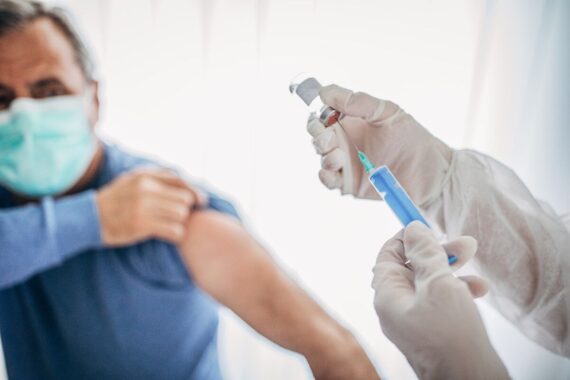The Government has ordered 4,500 smallpox vaccines to combat monkeypox, as new guidance recommended the jab for contacts with or without PPE.
The UK Health Security Agency (UKHSA) yesterday announced that it has identified further cases of monkeypox in England, and one in Scotland, bringing the total number of confirmed cases in the UK to 71.
It said that it has ‘purchased supplies of a safe smallpox vaccine’ called Imvanex, which is ‘being offered to identified close contacts of someone diagnosed with monkeypox to reduce the risk of symptomatic infection and severe illness’.
An UKHSA spokesperson confirmed to Pulse that 4,500 doses of the smallpox vaccine are available in total.
The vaccination of ‘high-risk’ contacts of monkeypox cases is already ‘underway’, with over 1,000 doses of Imvanex issued or in the process of being issued to NHS trusts, UKHSA said.
‘There remain over 3,500 doses of Imvanex in the UK,’ it added.
UKHSA also said that it is contacting those considered to be high-risk contacts of confirmed cases and advising those who have been risk-assessed and remain well to isolate at home for up to 21 days.
New UKHSA guidance published on Friday said that those at the highest risk from monkeypox should be subject to ‘self-isolation for 21 days, including exclusion from work’ and no travel.
It also set out which contacts should receive a smallpox vaccination – including those who come into contact with a confirmed monkeypox case or an environment contaminated with monkeypox while wearing appropriate PPE.
Who should get the smallpox vaccination for monkeypox?
UKHSA’s guidance says contacts of monkeypox cases who should receive a smallpox vaccination are –
Those at ‘high’ risk who had ‘unprotected direct contact or high-risk environmental contact’
- Defined as ‘direct exposure of broken skin or mucous membranes to monkeypox case (once symptomatic), their body fluids or potentially infectious material (including on clothing or bedding) without wearing appropriate PPE’
- Examples include body fluid in contact with eyes, nose, or mouth; penetrating sharps injury from used needle; contact in room during aerosol-generating procedure without appropriate respiratory PPE; changing a patient’s bedding without appropriate PPE; sexual contact; household contact
Those at ‘medium’ risk who had ‘unprotected exposure to infectious materials including droplet or airborne potential route’
- Defined as ‘intact skin-only contact with a symptomatic monkeypox case, their body fluids or potentially infectious material or contaminated fomite; OR passengers seated directly next to case on plane; OR no direct contact but within 1 metre of symptomatic monkeypox case without wearing appropriate PPE’
- Examples include clinical examination of patient before diagnosis without appropriate PPE; entering patient’s room without wearing appropriate PPE and within 1 metre of case; driver and passengers in shared car or taxi with case, or sitting next to case on plane; subsequent patients in consulting room after a confirmed case was seen and prior to room cleaning
Those at ‘low’ risk who had ‘protected physical or droplet exposure’
- Defined as ‘contact with confirmed monkeypox case or environment contaminated with monkeypox while wearing appropriate PPE (with no known breaches)’
- Examples include healthcare staff working in high consequence infectious diseases (HCID) specialist unit wearing appropriate PPE; person undertaking decontamination of rooms where a confirmed case has stayed while wearing PPE
All three of these groups should be offered the MVA-BN (Imvanex) jab ‘ideally within four days’ and up to a maximum 14 days from exposure, UKHSA said.
Post-exposure prophylaxis is ‘not usually required’ for those who have no physical contact but ‘unlikely’ droplet exposure – such as healthcare staff entering a patient room without PPE, without direct contact with the patient or their body fluids and maintaining a distance of more than 1 metre.
Source: UKHSA
Separate UKHSA guidance on vaccination against monkeypox, also published on Friday, said: ‘As monkeypox is related to the virus causing smallpox, vaccines designed for smallpox will likely provide a degree of cross-protection.
‘Previous data from Africa suggests that previous vaccines against smallpox may be up to 85% effective in preventing monkeypox infection.’
The guidance recommended that healthcare staff ‘due to care for a patient with confirmed monkeypox’ should have a ‘pre-exposure vaccination’.
UKHSA yesterday stressed that ‘while the current outbreak is significant and concerning, the risk to the UK population remains low’.
It said: ‘The virus does not usually spread easily between people, but it can be passed on through close person-to-person contact or contact with items used by a person who has monkeypox, such as clothes, bedding or utensils.
‘Monkeypox is usually a self-limiting illness and most people recover within a few weeks.’
Anyone ‘with unusual rashes or lesions on any part of their body’ should ‘immediately contact NHS 111 or their local sexual health service’.
‘A notable proportion of the cases identified to date have been among people who are gay, bisexual and men who have sex with men, so we are asking these groups in particular to be aware of the symptoms,’ UKHSA added.
UKHSA is currently investigating the source of the recent spread of monkeypox infections.
Pulse October survey
Take our July 2025 survey to potentially win £1.000 worth of tokens












